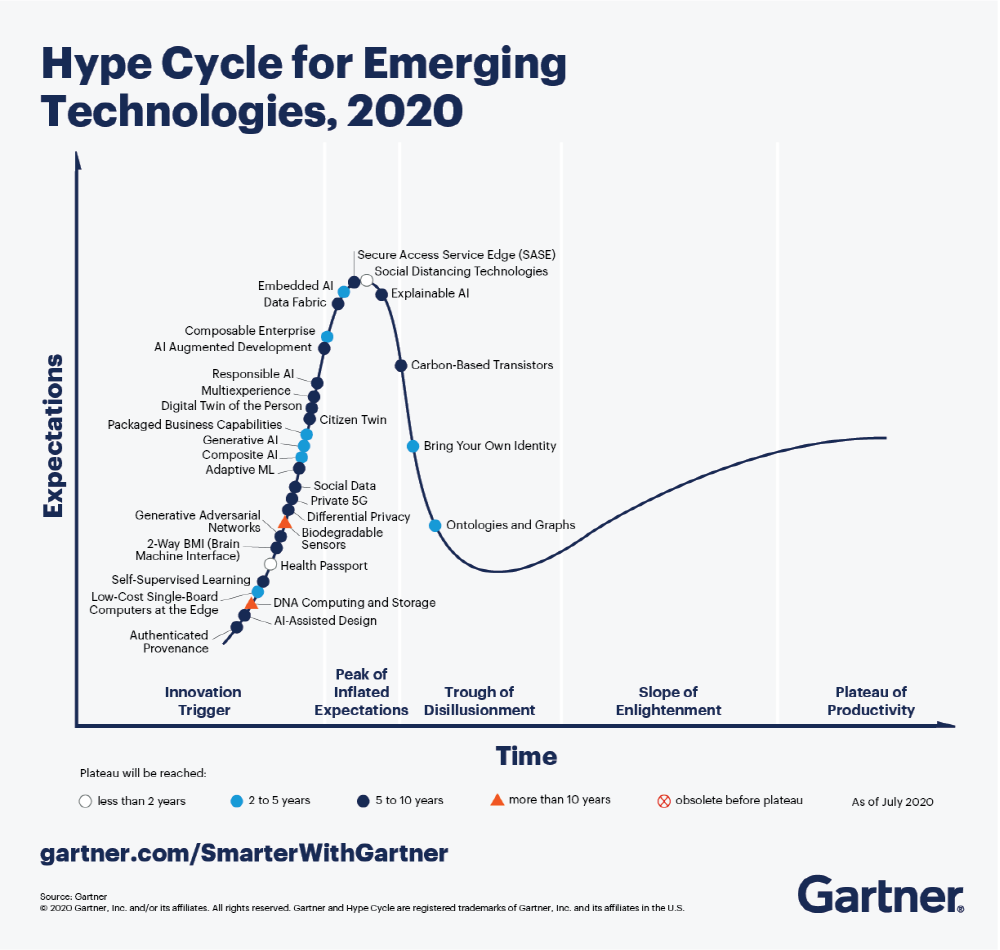
Each year, market research firm Gartner publishes the gartner hype cycle, a simplified representation of notable technology expectations and developments. Michael Maruni, who was in charge of marketing for VMware and Netscape, explains the eight lessons learned from analyzing data for the past 20 years on the authenticity of these trends and draws attention.
According to Gartner, the hype cycle categorizes the notable technology lifecycle into five distinct phases: dawn, high-expectation, disillusionment, enlightenment, and productivity stabilization. Maruni describes eight lessons learned from collecting and analyzing the Hype Cycle for Emerging Technologies over the past 20 years.
First, predicting the future is difficult. Of the more than 200 technologies that have appeared in the hype cycle so far, only a few technologies such as cloud computing, 3D printing, natural language search, and e-ink have grown as predicted. In this regard, Maruni says, it’s generally difficult to predict this.
The second lesson is that, surprisingly, many technologies disappear in an instant. According to Maruni, among the more than 200 technologies that have appeared in the hype cycle so far, more than 50 technologies have gained a certain amount of support, such as podcasts that appeared in the hype cycle only once and cloud sourcing that appeared in 2013. ) and social TV that appeared in 2011, there are many technologies that you cannot hear now.
The next thing is that many technologies don’t see the light. Of the technologies that appeared in the hype cycle over the years, 20% did not become mainstream and disappeared. Maruni cites UWB, paid RSS, WiMAX, and desktop Linux for business as examples of technologies that could not see the sunlight even though they appeared several times during the highly anticipated high season.
Among them, Mash Network appeared 9 times in 11 years from 2003 to 2013. However, Maruni said that it is difficult to build a mesh network even though he is not a network expert. He added that consumer mesh networks barely appeared on the market only recently.
The next thing is that there are many technologies that have not reached widespread use due to specification flaws. Some of the technologies appearing in the hype cycle still have the design idea itself, but there are technologies that have not reached widespread use due to specification defects. For example, the WS-compatible business model that appeared in 2003 is a technology that aims to communicate with computers with different environments, such as WS-Addressing and WS-Security, with a standardized protocol and message specification in a unified standard. was noticed as However, there were problems with many specifications, and developers were reluctant to use it, so it was not popularized. However, recently, standard specifications with similar functions have been disseminated.
Also, public authentication service, which appeared in 2002, is one example that has not been maintained in the age of technology. This technology was aimed at making authentication a single account for many services. However, due to flaws in the specification, it did not reach widespread use. However, in 2007, Google and Twitter collaborated to develop permission authentication technology (OAuth), and now users can log in to many services using accounts such as Google, Twitter, and Facebook. Maruni says the technology was a good idea but flawed in its specifications.
Here are some of the technologies that appeared in the hype cycle, some developed over several years. For example, speech recognition technology has been developed even after its first appearance at the end of 1995, and has recently been developed to the same level as humans due to the development of deep learning.
In addition, data analysis-related technologies continue to appear in the hype cycle over the past 20 years, changing names such as data mining 90s, data analysis 2000s, and big data 2010s. Maruni points out that new-generation architectures are always needed to cope with the ever-expanding scope and size of the data to be analyzed.
The next thing is that some technologies have not advanced at all. Quantum computers were considered as a technology realized more than 10 years ago in the 2000s. Maruni points out that quantum computers are still being treated as a technology realized more than 10 years earlier.
The next thing is that there are technologies going on without you even knowing it. After analyzing many words, Maruni says, even after deeming the technology to have been developed or failed, there were some that made periodic advances.
An example of a technology that has made significant advances is a head-mounted display. The head-mounted display, developed in the late 1990s, first appeared in 2001, but the development of the head-mounted display was temporarily suspended due to the limitations of display-related technology at that time. Nevertheless, recent advances in displays, motion sensors, and machine learning algorithms have led to the emergence of advanced head-mounted displays for VR and AR.
Last but not least, there are many key technologies that didn’t appear in the hype cycle. According to Maruni, many mainstream technologies have been developed that haven’t appeared in the hype cycle in the past 20 years. For example, x86 virtualization, which is essential for data center operation, and NoSQL, a database management system that does not depend on SQL, are mentioned. Related information can be found here.

